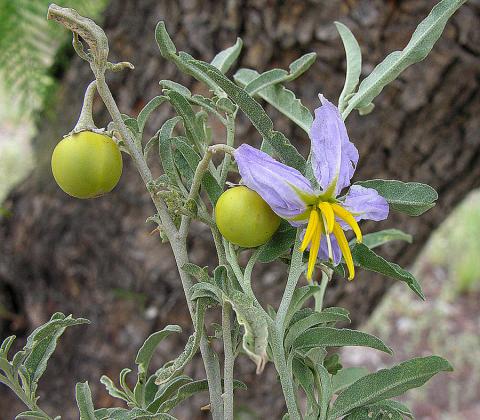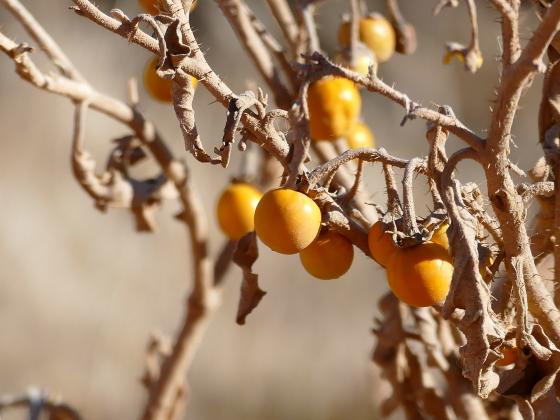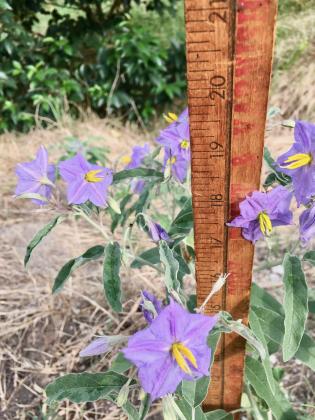Solanum elaeagnifolium – A vegetable rennet for cheesemaking
Solanum elaeagnifolium, trompillo, is a perennial seen in Grimes County for most of the year. It grows 1 to 3 feet tall on a prickly stem. Stem and alternate leaves, 2 to 4 inches long with wavy edges, are covered with fine silvery hairs. Another name for trompillo is silverleaf nightshade. It’s in the Solanaceae, nightshade family.
Flowers are purple, maybe white, about 1 ½ inches across, with 5 petals joined at the base forming a star. There are 5 bright yellow stamens at the center. Flowers bloom in spring and may stay until frost. In autumn you might see flowers and green, yellow, orange or red small tomato-like fruit on the same plant. In one year, each plant can produce 40 to 60 fruits, each with 60 to 120 seeds that remain viable in soil for 10 years. Trompillo dies back in winter but its ripe fruit stays on the branches.
Taproots can be 10 feet deep and interconnected so damaged roots get nourishment from neighbors. Segments less than one inch can remain viable for 15 months. In its native southern Texas and Central America, insects and the environment keep trompillo in check. But in many parts of the world and in some U.S. states it is invasive.
California dates its trompillo problem to the middle of the 19th century when the California Gold Rush (1848 - 1855) caused an increased demand for beef cattle. Railroads made moving cattle to the west coast profitable. But trompillo seeds contaminated the fodder and track ballast. Track ballast is dirt and crushed rock upon which the tracks sit, the trackbed.
Trompillo became invasive in Mediterranean countries when seeds arrived via American soldiers and equipment during World War II. Australia’s 1914 drought forced them to import hay from the U.S. It was contaminated with trompillo seeds and is now an invasive in their crops. Trompillo can grow in poor soil with little water which is why it is found in some Texas xeriscape gardens.
Traditional medicine systems use trompillo. To relieve toothache, smoke from the burned plant is held in the mouth or the chewed root is placed on the tooth. A poultice of the chewed root is put on snake bites. Sometimes the medicine man chewed the root and spit it out before sucking on the wound to extract the venom. It is being studied as a source for steroidal alkaloids that are used to make contraceptive and corticosteroid drugs. More information is at the Native American Ethnobotany Database, naeb.brit.org and at the National Institutes of Health, pubmed.ncbi.nlm. nih.gov.
S. elaeagnifolium is in the Food and Drug Administration Poisonous Plant Database at fda.gov. Birds, insects, gophers, etc. eat trompillo but it is toxic to many mammals including livestock and humans. However, North and Central American natives used the yellow fruit as a vegetable rennet to coagulate milk for cheesemaking. Today most rennet is from calves’ stomachs. Queso asadero, originally made in Chihuahua, Mexico, is a mild, semi-soft cheese that used trompillo rennet.
Deborah Richardson is a freelance reporter for The Examiner with a fondness for fl ora in its natural setting.




